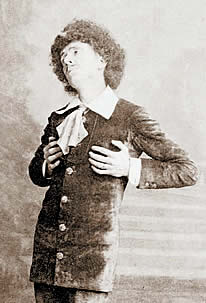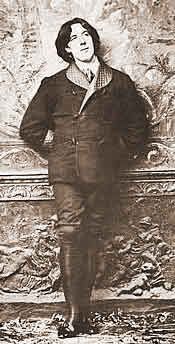 |
 |
||||||
Bunthorne and Oscar Wilde
by Andrew Crowther

Patience (1881) is in part a satire on the then-current fad for "aesthetic" art, poetry, clothing and furnishings, based on the principle of "art for art's sake", and on the cult following that some Aesthetes enjoyed. The latter had already been mocked in a series of cartoons by George du Maurier in 'Punch' magazine. A popular misconception is that the character of Bunthorne in Patience was based on Oscar Wilde. Wilde was one of these Aesthetes, but certainly not the only one, and the opera's satire was not aimed at any one person. Wilde was not yet the best known of the Aesthetes when Patience was written in early 1881, although he rapidly gained attention during that year and published his first book of poetry ('Poems') at the end of it.
Oscar Wilde later became associated with Patience for various reasons, including the American lecturing tour which he undertook, in 1882, at the instigation of producer Richard D'Oyly Carte, so that American audiences would understand the satire in Patience. Certainly Patience is linked with Wilde, in today's cultural memory, partly because Wilde has become the most famous of the Aesthetes. Any account of Wilde's life is almost certain to quote the line from Patience about walking "down Piccadilly with a poppy or a lily in your medieval hand". Because of what we now know about Wilde, there is a tendency to try and find homosexual hints in the portrayals of Bunthorne and (to a lesser extent) Grosvenor. This inquiry concentrates on the "effeminate" behaviour of the two characters.

Alan Sinfield's excellent book "The Wilde Century" (published by Cassell in 1994 as part of its Lesbian and Gay Studies list) argues, and gives much evidence in support, that the equating of "effeminacy" in men with homosexuality took place as a result of Oscar Wilde's trials in the mid-1890s, and that before that date "effeminacy" was in large part considered a symptom of an "unmanly" desire to attract women. Sinfield notes, for instance, that Wilde's "outing" as homosexual in 1895 was a surprise to many people, including the not notably pure-minded Frank Harris. A ballad printed at the time of the trials was entitled: "Oh! Oscar Wilde, we never thought that you was built that way." (p.2) Sinfield also notes in relation to the portrayal of Bunthorne in Patience that "the implication is narcissistic, not homoerotic" (p.92).
It is broadly accepted (e.g. by the biographer Richard Ellmann) that Wilde's first same-sex encounter took place in 1886, five years after the premiere of Patience. Another writer, Brian Reade, has suggested that this "initiation" took place while Wilde was at Oxford between 1875 and 1878, but this is far from clear from the evidence and would not have been any clearer to London society at the time (pp.5-6).
It is difficult for us to imagine how people saw Wilde in 1881, before the dark hints started being muttered in the early 1890s and the revelations became public in 1895. But it can be argued very persuasively that the public stereotype of the gay man was formed in the wake of the Wilde trial, that Wilde's behaviour became a convenient symbol of homosexuality as a result of the trials, and that the components of that behaviour ("effeminacy", "preciousness", waspish repartee, etc.) were not linked with homosexuality before that date. For instance, the fop of Restoration comedy is not portrayed as homosexual, merely affected and ludicrous.
Sinfield quotes on p.91 from a review of Wilde's 'Poems' (1881) in which the reviewer, Thomas Wentworth Higginson, complains that Wilde's effete writing has made him attractive to "women of high social position" and that the poems contain "offences against common decency". Higginson compares Wilde with Walt Whitman and comments on this difference between them: "Whitman's offences rest on a somewhat different ground and need not here be considered. Mr Wilde may talk of Greece; but there is nothing Greek about his poems." He makes a point of saying that Wilde's poetry is not offensively "Greek" like Whitman (i.e. homoerotic) but too "effete" (which he equates with an "unmanly" desire for female society).
In Patience, Bunthorne's behaviour is motivated by a desire for female admiration. He is surrounded by and followed by women — when he is not, he is miserable. The "manly" Dragoons go round in bulk, awkward and out of place when talking to the women, much more relaxed when amongst their fellows. The only way they can attract their women back is by wearing long-hair wigs and velvet suits, and standing in "effete" attitudes. All this is directly in accord with the way "effeminate" behaviour was seen at that time — as a way of attracting women. Look, for instance, at Frith's painting "A Private View at the Royal Academy, 1881" (1883):

Wilde is shown to the right of the picture, holding forth in probably a wonderfully entertaining way, surrounded by admiring women, one of them accompanied by a little boy in green. Frith explained that he wanted this part of the picture to be a critical portrait of "a well-known apostle of the beautiful, with a herd of worshippers surrounding him." (Quoted in Jeremy Paxman's book 'The Victorians', BBC Books, 2009, p.55).
Bunthorne is not based on Wilde. The most that can be said is that Bunthorne is related to the character Maudle in George du Maurier's 'Punch' cartoons, and that Maudle had some of Wilde's eccentricities. Bunthorne was the creature of Gilbert's brain, not just a caricature of particular Aesthetes, but an original character in his own right.
|
Page modified 8 June, 2009